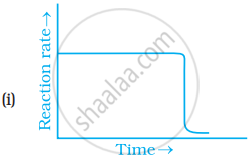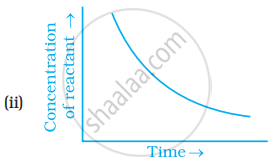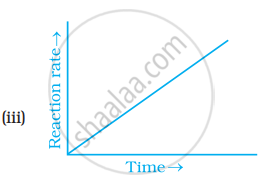Advertisements
Advertisements
प्रश्न
The decomposition of NH3 on platinum surface is zero order reaction. What are the rates of production of N2 and H2 if k = 2.5 × 10−4 mol−1 L s−1?
उत्तर
The decomposition of NH3 on platinum surface is represented by the following equation.
\[\ce{2NH3_{(g)}->[Pt]N2_{(g)} +3H2_{(g)}}\]
Therefore
`"Rate" = -1/2 ("d"["NH"_3])/"dt" = ("d"["N"_2])/"dt" = 1/3("d"["H"_2])/"dt"`
However, it is given that the reaction is of zero order.
Therefore,
`-1/2 ("d"["NH"_3])/"dt" = ("d"["N"_2])/"dt" = 1/3 ("d"["H"_2])/"dt" = "k"`
= 2.5 × 10−4 mol L−1 s−1
Therefore, the rate of production of N2 is
`("d"["N"_2])/"dt" = 2.5xx10^(-4) "mol L"^(-1) "s"^(-1)`
And, the rate of production of H2 is
`("d"["H"_2])/"dt" = 3 xx 2.5 xx 10^(-4) "mol L"^(-1) "s"^(-1)`
= 7.5 × 10−4 mol L−1 s−1
APPEARS IN
संबंधित प्रश्न
The reaction between A and B is first order with respect to A and zero order with respect to B. Fill in the blanks in the following table:
| Experiment | A/mol L−1 | B/mol L−1 | Initial rate/mol L−1 min−1 |
| I | 0.1 | 0.1 | 2.0 × 10−2 |
| II | ______ | 0.2 | 4.0 × 10−2 |
| III | 0.4 | 0.4 | ______ |
| IV | ______ | 0.2 | 2.0 × 10−2 |
The decomposition of NH3 on a platinum surface is a zero-order reaction. If the rate constant (k) is 4 x 10-3 ms-1, how long will it take to reduce the initial concentration of NH3 from 0.1 M to 0.064 M?
Give one example of zero order reaction.
Derive integrated rate law for a zero-order reaction \[\ce{A -> Product}\].
For which of the following reaction the units of rate constant and rate of the reaction are same?
Which of the following graphs is correct for a zero order reaction?




Write the rate equation for the reaction `2A + B -> C` if the order of the reaction is zero.
For a zero order reaction will the molecularity be equal to zero? Explain.
For a zero-order reaction, the plot of [A]t vs t is linear with a ______
The following experimental rate data were obtained for a reaction carried out at 25°C:
\[\ce{A_{(g)} + B_{(g)} -> C_{(g)} + A_{(g)}}\]
| Initial [A(g)]/mol dm−3 | Initial [B(g)]/mol dm−3 | Initial rate/mol dm−3s−1 |
| 3.0 × 10−2 | 2.0 × 10−2 | 1.89 × 10−4 |
| 3.0 × 10−2 | 4.0 × 10−2 | 1.89 × 10−4 |
| 6.0 × 10−2 | 4.0 × 10−2 | 7.56 × 10−4 |
What are the orders with respect to A(g) and B(g)?
Assertion (A): For a zero-order reaction, the unit of rate constant and rate of reaction are same.
Reason (R): Rate of reaction for zero order reaction is independent of concentration of reactant.
If the initial concentration of substance A is 1.5 M and after 120 seconds the concentration of substance A is 0.75 M, the rate constant for the reaction if it follows zero-order kinetics is ______.
What is zeroth order reaction? Derive its integrated rate Law. What are the units of rate constant?
Derive the expression for integrated rate law for zero order reaction A → Products.
If unit of rate constant is mol dm−3s−1, the order of reaction would be ______.
